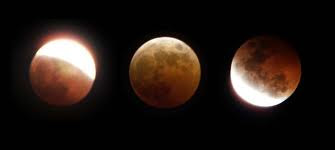The shadow of the Earth can be divided into two distinctive parts: the umbra and penumbra. Within the umbra, there is no direct solar radiation. However, as a result of the Sun’s large angular size, solar illumination is only partially blocked in the outer portion of the Earth’s shadow, which is given the name penumbra. A penumbral eclipse occurs when the Moon passes through the Earth’s penumbra. The penumbra causes a subtle darkening of the Moon's surface. A special type of penumbral eclipse is a total penumbral eclipse, during which the Moon lies exclusively within the Earth’s penumbra. Total penumbral eclipses are rare, and when these occur, that portion of the Moon which is closest to the umbra can appear somewhat darker than the rest of the Moon.
A partial lunar eclipse occurs when only a portion of the Moon enters the umbra. When the Moon travels completely into the Earth’s umbra, one observes a total lunar eclipse. The Moon’s speed through the shadow is about one kilometer per second (2,300 mph), and totality may last up to nearly 107 minutes. Nevertheless, the total time between the Moon’s first and last contact with the shadow is much longer, and could last up to 4 hours.[1] The relative distance of the Moon from the Earth at the time of an eclipse can affect the eclipse’s duration. In particular, when the Moon is near its apogee, the farthest point from the Earth in its orbit, its orbital speed is the slowest. The diameter of the umbra does not decrease appreciably within the changes in the orbital distance of the moon. Thus, a totally eclipsed Moon occurring near apogee will lengthen the duration of totality.
The timing of total lunar eclipses are determined by its contacts:[2]
- P1 (First contact): Beginning of the penumbral eclipse. The Earth's penumbra touches the Moon's outer limb.
- U1 (Second contact): Beginning of the partial eclipse. The Earth's umbra touches the Moon's outer limb.
- U2 (Third contact): Beginning of the total eclipse. The Moon's surface is entirely within the Earth's umbra.
- Greatest eclipse: The peak stage of the total eclipse. The Moon is at its closest to the center of the Earth's umbra.
- U3 (Fourth contact): End of the total eclipse. The Moon's outer limb exits the Earth's umbra.
- U4 (Fifth contact): End of the partial eclipse. The Earth's umbra leaves the Moon's surface.
- P2 (Sixth contact): End of the penumbral eclipse. The Earth's shadow no longer makes any contact with the Moon


